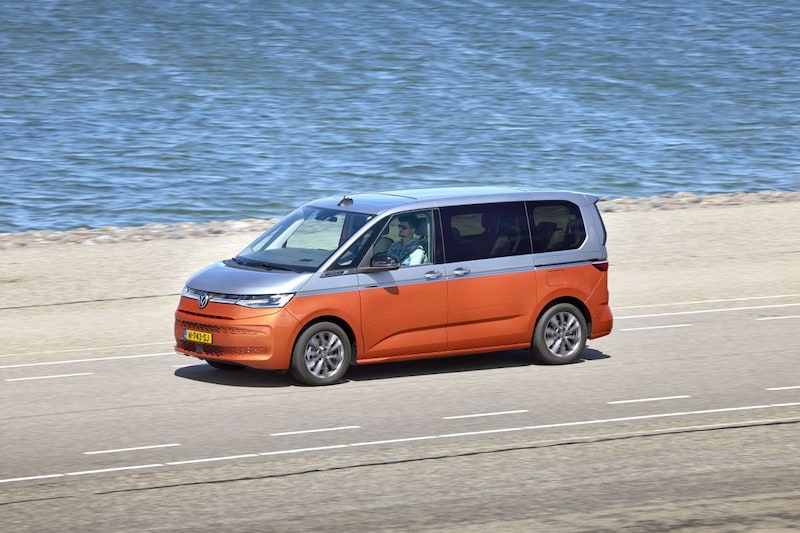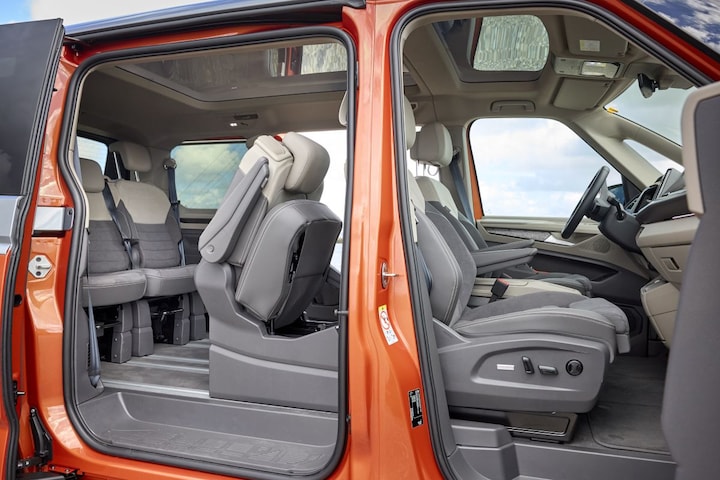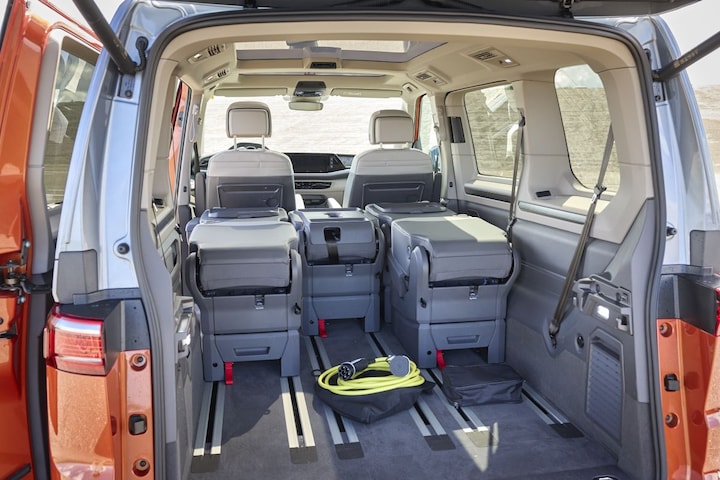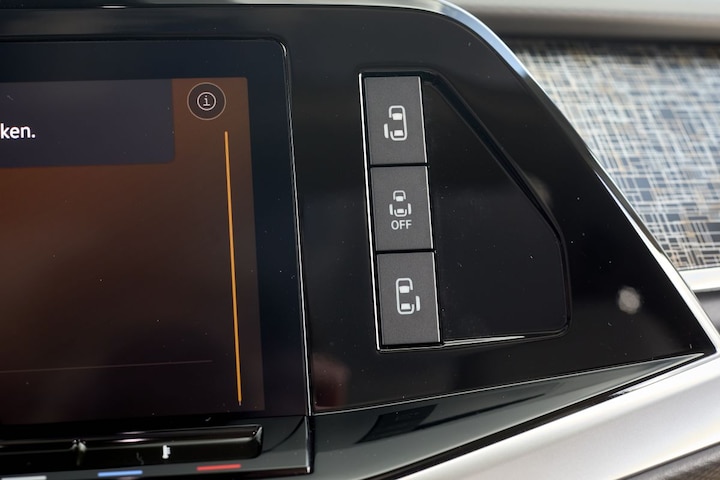You should know this about the Volkswagen Multivan

Passenger vans are usually unaffordable in the Netherlands. With a starting price of €56,000, the Volkswagen Multivan is a rare exception to that rule. This is mainly due to its plug-in hybrid technology: due to the low CO2 emissions, the bpm amount can remain nice and low. With its attractive price, this space giant from Volkswagen is a serious alternative to the standard SUV.
In addition to the Transporter T6.1 and the ID Buzz, Volkswagen also has the Multivan.
That’s right. The Multivan was unveiled in the summer of 2021. At that time, however, the marketing machine for the electric ID Buzz was already running at full speed. All media attention was absorbed by this modern interpretation of the classic Spijlbus, the T1. And the introduction of the Multivan passed almost in silence.
Volkswagen says that we should not see the T7 – as the Multivan is also called – as a replacement for the Transporter T6.1. It is on the modular MQB platform of the VW group and is much lower than the T6.1. This, together with the much more streamlined design, makes it less suitable as a delivery van. It is therefore all the more remarkable that Volkswagen wanted to invest so much time, money and energy in the development of an entirely new passenger bus.
What makes the Volkswagen Multivan so interesting?
The cost sheet. Until now, passenger vans, i.e. vans based on vans for seven or more occupants, had no chance on the Dutch market due to their high CO2 emissions. After all, the bpm amount is based on the CO2 emission. As a private individual, you paid at least €90,000 for a Multivan of the previous generation. No less than €33,000 was accounted for by the bpm. If you, as a private car owner, also drove around in a diesel, the car weight of 2,000 kilos meant that you also had to wait for an enormous financial loss for the road tax. That is why, apart from a few taxi or shuttle services, no one in the Netherlands bought such a car.
Thanks to electrification, however, there is hope for the passenger bus again. With the Mercedes-Benz EQV and the electrically powered vans of the Stellantis brands and Toyota, we already saw that happen a bit. You still pay at least 70 grand for such a fully electric passenger bus. Also the very fully equipped introduction version of the Volkswagen ID. Buzz is offered for that amount.

Unlike the electric ID.Buzz, the Multivan is available with three rows of seats. And all three are suitable for adults.
The Volkswagen Multivan has plug-in hybrid technology, which on paper seems perfect for the Dutch car buyer who needs a lot of seats. The Multivan shares its powertrain with the Arteon eHybrid, but with different power and performance figures, the same combination of a 1.4-litre four-cylinder and electric motor is used in many other models from the VW stables. Thanks to the low theoretical CO2 emissions, the bpm remains very within limits and the new Multivan with an entry price of just over €56,000 euros is just 34 grand cheaper than its predecessor.
Because the car emits less than 50 grams of CO2 per kilometer on paper, you also benefit from the half rate for road tax. All financial advantages that suddenly make this spacious bus a very attractive alternative to large seven-seater SUVs such as the Hyundai Santa Fe, the Kia Sorento and, from VW’s own house, the Seat Tarraco and Skoda Kodiaq.
What does the Volkswagen Multivan have to offer more than an SUV?
The Multivan is offered in two different lengths, which are called L1 and L2 in the price list in a very commercial vehicle-like way. The car is tall, has flat sides and has a fairly straight line – a real bus, in other words. As a result, it looks less tough than an SUV and in some circles it may require some explanation, especially if you choose to use it (on your own) for business. But with its two-tone bodywork, the tested Multivan scores a lot of prying eyes on the road: is it the electric ID Buzz? Not so, it is a lot smaller and much hipper than the Multivan.
With these types of cars, everything revolves around the interior. Even though the test car is the short(er) L1 version, the interior space is really huge and the seats are high on the flat, low floor. They do not fold away in that floor, if you want to use the entire load space of 3,672 liters (an unprecedented volume in passenger car land!) You have to lift them out of the car. Volkswagen does not specify how large the luggage space behind the third row of seats is, but it is significantly more than the aforementioned seven-seater SUVs have to offer.

You can remove the seats and suddenly you have (almost) a company car worth of space.
Also useful: the sliding console between the front seats. Although it is not standard, you can take it far back via a long rail, after which two serious table tops can be folded out, among other things. All chairs have separate armrests on both sides. However, the side windows cannot be opened, as is often the case with vans. A small sliding window is available at extra cost. The Volkswagen Multivan 1.4 eHybrid is allowed to tow a trailer of 1,600 kilos.
Does the Multivan want to keep up with the rest of the traffic?
In other countries, the Multivan is also offered with petrol and diesel engines, in the Netherlands it is only available as a plug-in hybrid. Its powertrain, as with other Wolfsburg PHEVs, is built around a 1.4 TSI petrol engine and a six-speed dual-clutch DSG transmission that shifts smoothly and quickly. The TSI, the DSG and the electric motor work together in a nice way. In the Multivan, this combination reaches 218 hp, more than enough to help it achieve good performance. In the brochure, Volkswagen states an acceleration time of 11.8 seconds, we managed to sprint from a standstill to 100 in 8.8 seconds.
On current we came 58 kilometers away. Without first charging the battery, we arrived at a fuel consumption of 1 to 13.9). For such a large, 2,122 kilo heavy car, that is not a bad result at all. Via a ‘slide bar’ on the screen you can also regulate exactly how much power you want to keep on hand to drive completely CO2-free to your destination in the city.
How does the Volkswagen Multivan behave on the road?
The high seating position behind the wheel is actually only approached by the Range Rover. You sit very upright and high above the floor, which will take some getting used to for drivers who normally drive a passenger car. The overview all around is pleasant and the view to the rear is simply fantastic due to the many large windows. The dashboard is very reminiscent of VW’s passenger cars, with a digital instrument panel and a multimedia system that includes all important functions. We also find the ‘sliders’ for the temperature control in the Multivan – and we are not a fan of that. Compared to VW passenger cars, the use of materials is at a slightly lower quality level. However, a lot of space has been created in and around the dashboard for small items.

Also very nice: normal push buttons on the steering wheel instead of the user-unfriendly touch buttons of the ID models.
Although the Multivan is based on a passenger car platform, you can feel that it is designed for a high payload. The suspension comfort fits perfectly with a van, where some ‘droning’ can sometimes be heard from the suspension. In any case, quite a few driving noises are audible, but that may be unavoidable in such a large sound box. The Multivan does get kudos for its stability at high speed. It turns out to be excellent during a long drive on German autobahns.
What goodies does the Volkswagen Multivan have to offer as standard?
Volkswagen supplies the Multivan in four different versions. The basic version of €56,000 is only available as a five-seater car, if you want to be able to accommodate seven occupants, you must at least have the Life (from over €59,000). Compared to the basic version, that model has, among other things, an automatically closing tailgate, sliding doors with closing aid, a light sensor, nicer upholstery, air conditioning with air supply to the rear, parking aid at the front and rear and a light and rain sensor. Things that make life on the road just that little bit more pleasant.
For a very modest surcharge of €510, Volkswagen supplies you with the Multivan Life Business. Everything that the Life already has as standard is supplemented with, among other things, privacy glass from the B-pillars, PreCrash Basic (which anticipates an approaching collision and, for example, tensions the seat belts), a reversing camera, the sliding center console with folding tables, 18-inch alloy wheels (instead of 17-inch), automatic climate control with three temperature zones, a wireless phone charger and navigation. Incidentally, every Multivan has a multimedia system with smartphone integration and online services as standard.
The top model is the Multivan Style, which is listed for almost €66,500. It has, among other things, a chrome package, a grille with LED lighting, fully electrically operated sliding doors, LED matrix headlights with adaptive light beams, chic interior panels, seats covered with velor and artificial leather, parking assistance and seat heating in the front.

Electric door operation is only standard on the most expensive Style.
Perhaps a bit disappointing is the Multivan’s safety equipment. An airbag between the driver and the co-driver, an emergency brake assistant with recognition of pedestrians and cyclists (also when reversing), an evasion and turning assistant are all included, but for adaptive cruise control, blind spot warning, a lane assistant or a high beam assistant, you all have to pay extra. These are features that are often supplied as standard with competing SUVs.
The choice of AutoWeek test coordinator Marco Gorter
Unless you really want to empty the entire Ikea regularly, the L1 version is more than enough space. The only powertrain is the plug-in hybrid, so there is little to choose from. The potential buyer will have to take a good look at which (safety) systems are important. They are not all standard, so a Life Business is recommended. Also because it has a reversing camera, which can be very pleasant with such a large car.
.
– Thanks for information from Autoweek.nl